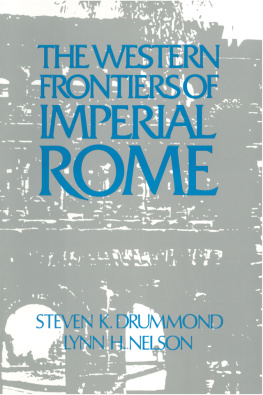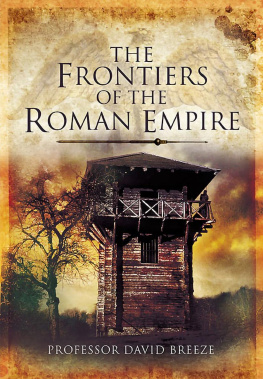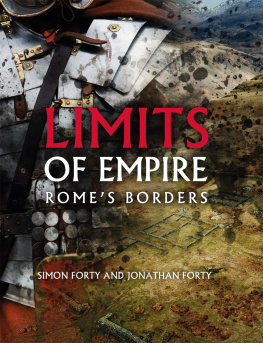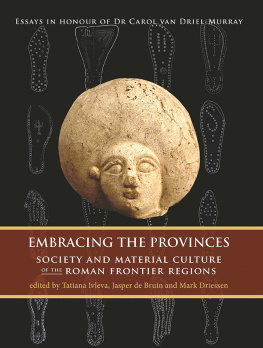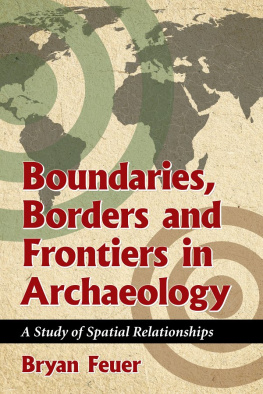First published in Great Britain in 2011 by
Pen & Sword Military
an imprint of
Pen & Sword Books Ltd
47 Church Street
Barnsley
South Yorkshire
S70 2AS
Copyright David J. Breeze 2011
ISBN 978-1-84884-427-8
eISBN 9781848849082
The right of David J. Breeze to be identified as Author of this Work has been asserted by him in accordance with the Copyright, Designs and Patents Act 1988.
A CIP catalogue record for this book is available from the British Library.
All rights reserved. No part of this book may be reproduced or transmitted in any form or by any means, electronic or mechanical including photocopying, recording or by any information storage and retrieval system, without permission from the Publisher in writing.
Typeset in 11pt Ehrhardt by Mac Style, Beverley, E. Yorkshire
Printed and bound in the UK by CPI
Pen & Sword Books Ltd incorporates the imprints of Pen & Sword Aviation, Pen & Sword Maritime, Pen & Sword Military, Wharncliffe Local History, Pen and Sword Select, Pen and Sword Military Classics and Leo Cooper.
For a complete list of Pen & Sword titles please contact
PEN & SWORD BOOKS LIMITED
47 Church Street, Barnsley, South Yorkshire, S70 2AS, England
E-mail: enquiries@pen-and-sword.co.uk
Website: www.pen-and-sword.co.uk
Acknowledgements
I have been lucky to have worked intensively on two frontiers in Britain, Hadrians Wall and the Antonine Wall; fortunately, both retain the ability to surprise through new information obtained from excavation or as the result of research in the study. I have also visited the whole of the European frontier from Katwijk on the Dutch coast to the Black Sea with the exception of modern Serbia, much of the eastern frontier but only a small section in North Africa. In spite of several visits to some areas, I would not admit to having more than a limited knowledge and am grateful to the many friends and colleagues who have helped me visit frontiers and understand them better and who have discussed frontier problems with me over many years, and in particular those who have read and commented on earlier drafts of this book as well as colleagues who have helped with references. These include Dietwulf Baatz, Alan Beale, Paul Bidwell, James Bruhn, Walter Cockell, Orietta Cordovana, Brian Dobson, Beryl Elliott, Bill Errington, George Findlater, Phil Freeman, Erik Graafstal, Bill Hanson, Nick Hodgson, Sonja Jilek, Rebecca Jones, Valerie Maxfield, Ioana Oltean, Andrew Poulter, Boris Rankov, Alan Rushworth, Sebastian Sommer, Matthew Symonds, Andreas Thiel, Zsolt Visy and Willem Willems. Jackie Henrie has applied her considerable skills as a copy editor to the text, for which I am most grateful. I am also grateful to Phil Sidnell of Pen & Sword for inviting me to write this book.
While I was working on this book I was invited by Professor Bill Hanson to give the Dalrymple lectures at the University of Glasgow. This was useful in helping me to shape and firm up many ideas which are detailed here and I am grateful to the members of the audience for their feedback.
I should like to thank Richard Beleson for financial assistance with the illustrations, and the following for help with providing the illustrations: Jim Devine of the Hunterian Museum, Kurt Schaller of the University of Salzburg who prepared all the maps, Graeme Stobbs who provided several plans, and Andreas Thiel.
I am grateful to the following publishers for permission to reproduce translations: Professor A. R. Birley; Professor Brian Campbell; Dr. J. S. Johnson; Gerald Duckworth & Co. Ltd (Bristol Classical Press); The publishers and Trustees of the Loeb Classical Library, Cambridge, Mass.: Harvard University Press, for the quotations from volumes 2, 111, 176, 249, 263 and 454, by the President and Fellows of Harvard College. Loeb Classical Library is a registered trademark of the President and Fellows of Harvard College; Liverpool University Press; Penguin Books Ltd.
Picture acknowledgements
AirFotos, Newcastle upon Tyne pl. 14; Bayerisches Landesamt fr Denkmalpflege (photograph Otto Braasch) pl. 20; Culture 2000 Project Frontiers of the Roman Empire Frontispiece; Deutsche Limeskommission pls. 9 and 11; Dietwulf Baatz figs. 12, 13, 21, 22; William S. Hanson fig. 10a; Historic Scotland fig. 19, pl. 17; Hunterian Museum pls. 1ae, 18; Simon James pl. 25; Angus Lamb pls. 36; Michael Mackensen pl. 26; Valerie Maxfield 41, pl. 28; Michael J. Moore figs. 79, 17, 20; Belinda Ratnayake pl. 2d; Roman Society fig. 5; Rmisch-Germanisches Zentralmuseum, Mainz pl. 7; Kurt Schaller/University of Salzburg figs. 11, 14, 18, 24, 25, 28, 34, 35, 38, 39, 40, 4245; Society of Antiquaries of Newcastle upon Tyne figs. 15, 16; Graeme Stobbs figs. 10b, 26, 2933, 37, 46, 47, 48; TimeScape fig. 3; Tyne and Wear Archives and Museums pl. 16; Utrecht pl. 10; Vindolanda Trust pl. 8. Other photographs are copyright of the author.
Technical Matters
A ll dates are within the CE (Common Era, AD as it used to be known) unless otherwise stated to be BCE (Before the Common Era, BC ). In most cases, both the Roman and modern names of a site are given when known, e.g. Vindonissa /Windisch, the Roman being in italics. Some sites such as Alexandria, Petra and Vindolanda are so well known by their ancient names that these have not been italicised. Measurements are in metric with imperial (i.e. American/British) in brackets. Roman measurements are given when they are significant. Ancient sources are cited in translation in the text with the source of the translation referenced in the section on Further Reading; they are referenced by author, book, chapter and verse. Many translations are now available on-line. End notes have been provided for the citing of secondary sources, but I have not sought to reference every statement relating to books listed in the Further Reading. Publications which appear in the Further Reading are referenced in the end notes by author, date and page reference; other publications appearing in the end notes are cited in full. There is frequent mention of specific Roman emperors. Rather than give their dates every time, a list of the main emperors is provided below. There are different words for the edge of a state: border, boundary, frontier. I have generally used frontier in connection with military works and border or boundary to describe the legal boundary. There should undoubtedly be more qualifying words such as possibly, probably and perhaps throughout the text, but I have sought to indicate the degree of uncertainty behind the statements made below.
Maps
Kurt Schaller and I have tried to make the maps as accurate, clear and consistent as possible. Sometimes, these aspirations clash. For example, although most of the forts on Hadrians Wall and the Antonine Wall were attached to the linear barrier, for cartographic ease they are shown depicted as if not attached. On the maps a triangle indicates a legionary fortress, a square an auxiliary fort and a circle a town; a black square indicates certain occupation, a white square probable/possible occupation, and a grey square occupation at a different time from the main period of the map. In order not to over-burden the maps, fortlets and towers are generally not marked. Where, on occasion, a different convention is used, an explanation is given in the caption. Only sites mentioned in the text are named. Main rivers and seas are also named and significant roads shown. Provincial boundaries of the second century are marked, as on the map of the empire appearing as the frontispiece. There will inevitably be disagreement about the dates of occupation of some forts and it is all but certain that not all the forts shown on each map were occupied at the same time; we have done our best with the available evidence. As far as possible, maps (and plans) are reproduced at the same size for comparative purposes.


